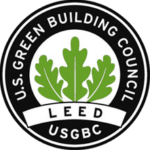Building designers and developers that are pursuing the Heat island reduction credit for LEED certification require documentation of the Solar Reflectance Index (SRI) for their project’s roofing materials, shade giving structures, and paving materials.
Under the U.S. Green Building Council’s LEED 2009 rating system, credits SSc7.1 and SSc7.2 (combined as credit SSc5 in LEED v4) are intended to minimize effects on microclimates and human and wildlife habitats by reducing heat islands. To satisfy the requirements of the Heat Island reduction credits, a certain percentage of the hardscape and roofing must have a high solar reflectance index.
How Do I obtain SRI Values for My Building Materials?
LEED requires specific SRI values for your individual product or material. Many roofing manufacturers have already obtained independent laboratory testing of the SRI of their product catalog. Your desired roofing or hardscape SRI specifications may be readily available in the form of a manufacturer datasheet which can be used as LEED documentation.
In cases where the manufacturer can not provide the SRI of a material, or the manufacturer is unknown, the USGBC allows for SRI values to be obtained from a laboratory following the appropriate ASTM standards for reflectivity and emissivity testing.

